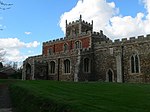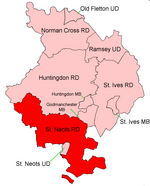Little Paxton

Little Paxton in Cambridgeshire, England is a village and civil parish that lies 5 miles (8.0 km) south of Huntingdon and 1.7 miles (2.7 km) north of St Neots. It is in the district and historic county of Huntingdonshire. Until the 1970s it was a minor village and the church was under threat of closure. The building of a housing estate and a junior school revived its fortunes and the establishment of the Paxton Pits Nature Reserve around part of the nearby gravel pits has brought visitors to the village. The nature reserve features lakes, woodland and part of the Ouse floodplain and is home to large numbers of cormorants and many summer visitors such as nightingales and a large number of passerine birds. Grebes, ducks and geese have colonised the lakes. The population of the village of Little Paxton is now much larger than that of Great Paxton.
Excerpt from the Wikipedia article Little Paxton (License: CC BY-SA 3.0, Authors, Images).Little Paxton
Boardman Close, Huntingdonshire Little Paxton
Geographical coordinates (GPS) Address Nearby Places Show on map
Geographical coordinates (GPS)
| Latitude | Longitude |
|---|---|
| N 52.25 ° | E -0.25 ° |
Address
Paxton Pits
Boardman Close
PE19 6NF Huntingdonshire, Little Paxton
England, United Kingdom
Open on Google Maps







